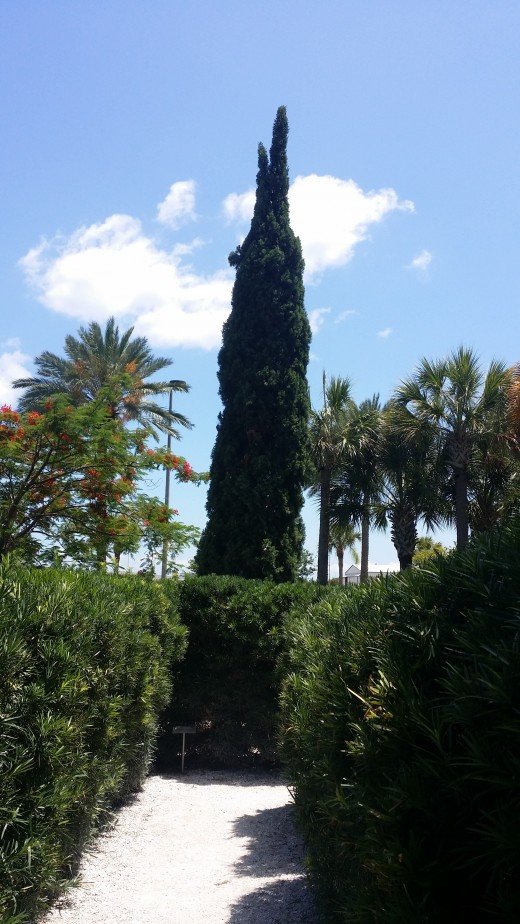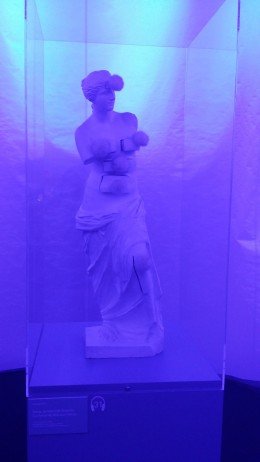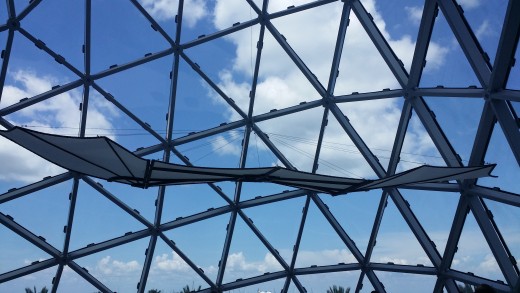Visiting the Dali Museum in St. Petersburg, Florida

While vacationing in Florida during the summer of 2015, my mother and myself went to see the Dali Museum in St. Petersburg. As I toured the place, I learned from the museum's press statements that the reason the patrons picked St. Petersburg originated from its resemblance to Cadaqués and Port Lligat, Dali’s homes/personal muses. Looking at the trees and the port and comparing them to his body of work, I understood the reasoning. The museum, while they do not have the Surrealists' Persistence of Memory, they do have a very comprehensive timeline of his art, from the experimental early years full of Impressionist (but normal looking) landscapes to his final science driven pieces full of grandeur and bombast
The building's exterior and interior, plus the museum's lawn.
The building itself has a gray industrial design, but inside, there's a white interior with a glass ceiling and a spiral staircase. The stair's wide spiral design must act as a homage to Dali’s delirious creativity. The museum’s’ labyrinth lawn design pays homage to Dali’s interest in Greek mythology and playful nature.
In a labyrinth

A Dalinian Introduction
However, before the visitor is able to explore the early works, the exhibition introduces you to Daddy Longlegs of the Evening-Hope! Dated in 1940, Dali renders the bodies in the painting as malleable to the point of being gooey. Furthermore, since Dali never shied away from the bombastic, the painting has cannons shoot out horses and angels.
After that introduction, I finally went through his early years as an artist. Thick and executed with the flair of a Impressionist, the paint bulges substantially in his depictions of Cadaqués. Also interesting to look at the kind of material Dali painted on, such as knitted canvases or smooth panels.
Dali is watching you

Dali's Surrealist Stories
The museum created a timeline of Dali’s themes. For example, the paintings Girl’s Back and Fantasies Diurnes sees the beginning of his use of a female's back, amorphous shapes, and barren landscapes. Also, if you click on Fantasies Diurnes, his profile found in Persistence of Memory makes a cameo appearance in a tiny red seal. Seeing them all as a whole, I think of them all as an ensemble cast taking part in a grand story only known to Dali.
To elaborate, the rest of his paintings show other repeating motifs: Auger shells, people’s backs, keys, Giacometti style bodies, canes, people as specks overwhelmed by empty landscapes, and, of course, Dali’s self-portrait appearing in multiple variations. Some subjects and objects take a prominent role while others hang out in small sections. To further drive my point home, people and things appear as main characters in one painting, while then appear tiny in another. Such as the philosopher Voltaire appearing in Slave Market with the Disappearing Bust of Voltaire, and then the eponymous bust making a cameo in The Hallucinogenic Toreador. The figure in The Average Bureaucrat shows up again in the painting Puzzle of Autumn.
To put it in another way, Dali created an anthology of stories with characters appearing and reappearing in his works until his death.
I am sure he probably revealed them in writings I have not read yet, and there are experts with a much stronger theory, but I am going with this until I see something that changes my mind.
Other miscellaneous observations
Dali occasionally made some political statements in his art. His 1932 painting Suez commemorates the Canal but at the same time, he depicts a painting of Ancient Egypt in the trash while some Classical sculpture style figures appear to have a conversation.
Fascinating artwork from a man who looked to the future and the past for inspiration.
Dali shows his playful side with humorous titles such as 1934’s The Ghost of Vermeer of Delft Which Can Be Used as a Table. The humor continued with Eggs on the plate without the plate.
When I first saw Gala contemplating the Mediterranean Sea which at Twenty Meters Becomes the portrait of Abraham Lincoln–Homage to Rothko (1976), I wondered what went on in Dali’s mind. This article from Scientific American I found while editing this review helped clarify Dali’s purpose.
Dali's Venus de Milo

Dali and Da Vinci
His reproduction of the Venus de Milo (he reproduced the statue and in the process, added his own modifications) in the Breathing Room gently assaults the senses with the rhythmic breathing and changing color. Those were my observations before I came across the news report I linked. The room as a whole conveys an intimate environment. The museum also has an exhibition of Dali’s experiments in machinery. On a repeating loop, one screen had a video showing Dali demonstrating a machine. At the same time, there was an exhibition of Leonardo da Vinci’s mechanical designs.
Dali and Da Vinci shows Dali’s ability to look towards the future, with his experiments and his desire to not just stand on the shoulders of giants.
Da Vinci's inventions take flight (and make a cameo appearance)
